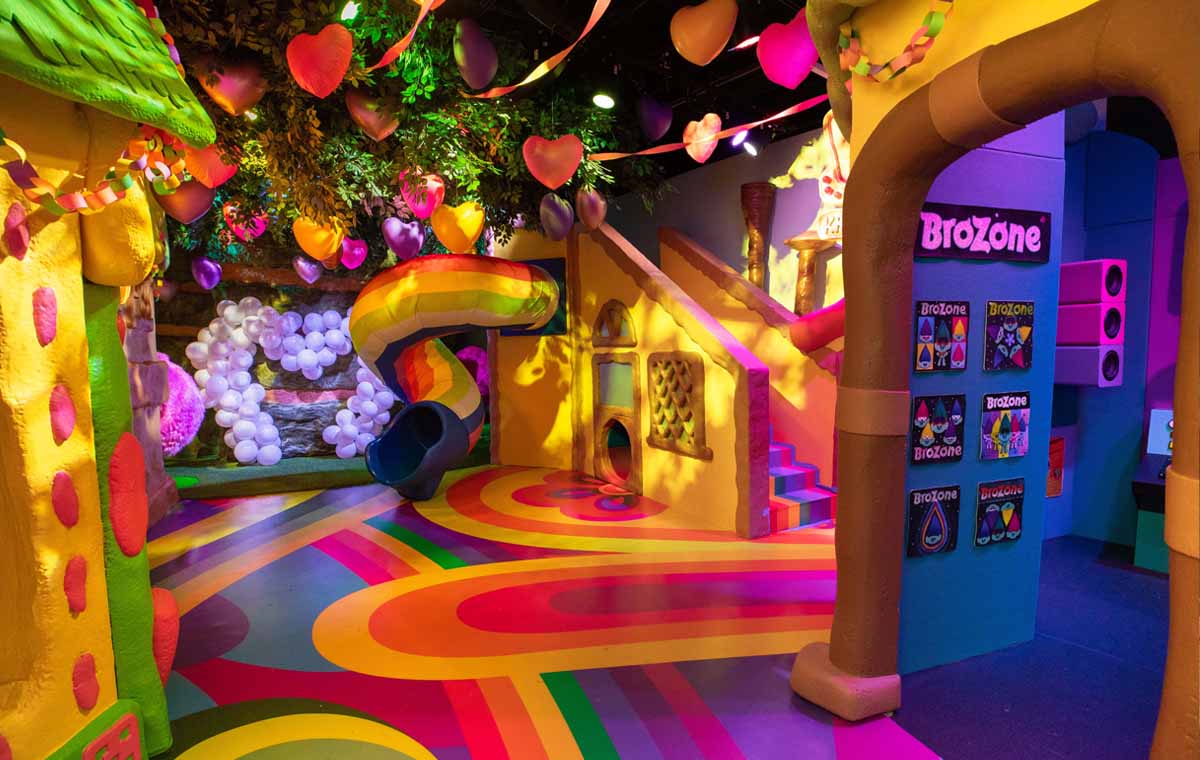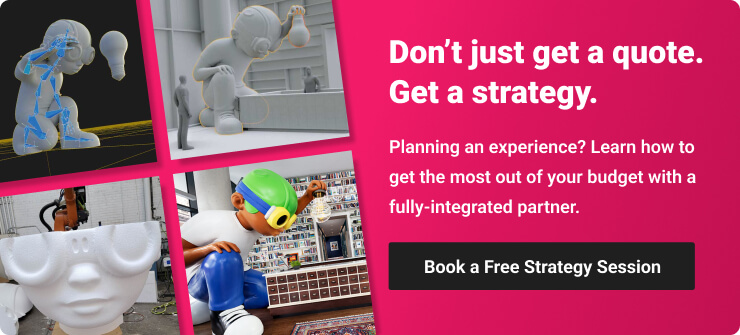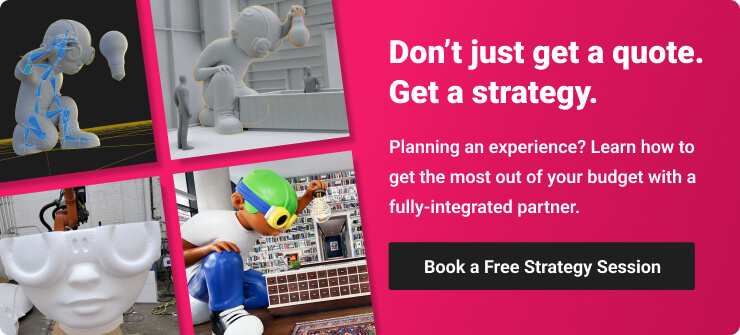It's tough out there. In today's increasingly crowded (and noisy) market, making your brand stand out from the pack is no small task. Customers have brands jockeying for their attention in their inbox, in their social feed, on every website, and -- let's not forget -- also in real life. So how can brands differentiate from the competition?
Immersive environments.
As technology continues to evolve, consumer expectations continue to rise – and traditional forms of marketing are losing the impact they once had. This is where creating an immersive environment can make all the difference. Whether you are embarking on a temporary brand activation or a full-scale commercial interior redesign, immersive environments provide an unforgettable experience for customers and create a lasting emotional connection with a brand.
By seamlessly merging physical spaces with digital and multi-sensory elements, businesses can engage their audience on a whole new level and help their brands stand out. In this article, we'll discuss 10 tips for creating exceptional immersive environments to captivate your target customers and elevate your overall marketing strategy.
What is an Immersive Environment?
Immersive environments are intentionally designed spaces that surround guests with a multi-sensory experience of a brand, institution, or organization. Immersive environments help the brand tell a story by allowing audiences to engage directly – experiencing the brand in 3 dimensions – through fixtures, furnishings, and design elements. The idea is to layer the aesthetics, values, and unique value proposition to communicate the brand's ethos, often without saying a word.
10 Tips for Creating Exceptional Immersive Environments
Creating unforgettable immersive environments for brands is both an art and a science. It requires a deep understanding of consumer behavior, creative vision, and flawless execution. These tips will help elevate your next brand experience and leave a lasting impression on your customers.
1. Have a Clear Goal
When planning an immersive environment for a new brand experience, the very first question to ask is, “What are we trying to accomplish?” That objective, whether it’s an emotion or an action should act as a touchstone throughout the entire design and production process. That answer should guide every decision you make along the way, and will help prevent the original kernel of intention from getting lost in the details and creative possibilities that can otherwise be distracting.
2. Leverage Technology Wisely
It’s all too easy to get caught up in the bells and whistles of trendy tech and lose sight of what you are trying to accomplish with an immersive experience. When it comes to technology, always start with the story you want to tell and then determine the best way to tell it. Do you need a user-led interactive touchscreen, a giant LED wall, virtual or augmented reality, or maybe a lighting or sound immersion that’s triggered by motion? Avoid technology for technology’s sake. Use it only where it makes the most sense to your goal and truly enhances the visitor experience.
3. Engage the Senses
Ever bite into a particular type of food or encounter a scent from your childhood and be instantly transported back in time? Multi-sensory experiences are powerful that way. By engaging the senses in an immersive environment you make the experience more memorable while adding elements of surprise and delight for the audience. While visual and audio elements are fairly common, be sure to consider textures, scents, and even tastes that can fully envelop participants and leave a lasting impression. However, it’s important to note that a little can go a long way with sensory stimulation, particularly scents. You want your guests to be enchanted but comfortable in the space, not overwhelmed and headed for the door.
4. Embrace Authenticity
What’s the story of your campaign? What is your target audience most going to resonate with? How can you bring that to life through an immersive environment? Be true to your brand, its values, its story, and its existing customer base when planning your project. The better you understand your audience, what challenges they face, where and how they like to spend their time, and what thrills (or bores) them, the more impactful and successful your experience will be.
5. Create Destination-Specific Features
Where will your immersive environment be located? For bigger national brands, leveraging local pride can add an element of personalization and exclusivity to an experience. Partner with local artists to add visual or sound elements, and incorporate cultural references, local landmarks, or regionally specific food or drinks to tie the immersion to the broader community. Working with local artists and vendors also fosters real connections in the community, boosts brand loyalty, and creates a community around your brand.
6. Blend the Physical and Virtual Worlds
Extend the impact of your brand experience by inspiring guests to take the experience with them through creative tactics that combine physical and digital experiences. Inspire guests to share images on social media by offering photo stations, custom hashtags, or product discounts, or leverage QR codes that allow customers to enjoy a Mixed Reality experience onsite or get access to extended virtual experiences available from anywhere. By connecting your physical immersive environment with a virtual one, you make it easy for visitors to amplify your reach and generate earned media exposure.
7. Elements of Surprise
Here’s a fun fact: People never outgrow the need for play. Bespoke brand experiences are the perfect place to incorporate playful details, like hidden passages, scavenger hunts, and other unexpected interactions that genuinely surprise and delight customers and inspire loyalty to your brand. So think boldly, avoid predictability, and don’t be afraid to get creative in your approach.
8. Create a Narrative
Can a space tell a story? It absolutely can. Make your brand experience a journey by guiding visitors through your immersive environment intentionally. Set the stage, introduce the characters, or better yet – make them the character – add a conflict or problem to be resolved, and finally, guide them toward the resolution. We are wired to not only pay attention to stories, but to remember them – and taking a narrative approach will boost audience engagement and ensure customers recall the experience long after.
9. Encourage Interaction
Your favorite sports team wins, you go to an epic concert, or maybe you witness a breathtaking sunrise with a friend or family member – these are all shared interactive experiences that powerfully bond people together. Immersive environments can nurture that kind of experience by providing ways for the audience to interact with each other within the space. By leveraging interactive elements and carefully managing the flow of traffic throughout an immersive experience, brands can encourage guest interactions – even among strangers – that create the feeling of a unique shared experience.
10. Be Realistic (and Transparent) about Your Budget
While the sky’s the limit when it comes to modern immersive environments, the sky is seldom the limit when it comes to budgets. One of the very best ways to get the most from your experience is to be honest with your design and production partner about the numbers in the first place. An experienced partner can help strategize what means and methods will best meet your goals, engage your audience and differentiate your brand without blowing your budget. It’s also helpful to extract and set aside funds for hard costs like permits, space rental, shipping, and installation which are very real expenses but shouldn’t be considered part of the budget for creating the experience itself.
“With any experiential project, the balance between what's possible and what’s possible within budget is constantly in conflict.”
ERIC CUP
CEO, BRIDGEWATER STUDIO
Immersive Environments: Final Thoughts
While it may not be possible to incorporate every one of these 10 tips into your next project, using them as a guide can help you create exceptional immersive environments that will truly captivate consumers and leave a lasting impression of your brand. So don't be afraid to think outside the box, experiment with new technologies, and embrace the power of storytelling, surprise, and authentic experiences. The result will be an unforgettable immersive environment that will help your brand stand out in a crowded market.
Here at Bridgewater Studio, we help brands create unique and compelling immersive environments for product launches, festival or industry events, commercial interiors, and much more. As an all-inclusive partner for strategy, design, and production, our clients benefit from working with a single team for every stage of a project, from conception through completion. Our streamlined process enables clients to think big and deliver exceptional experiences for their customers while staying on time and within budget. Learn more by booking a no-obligation strategy session with Bridgewater today.


.png)
.png)
.png)








